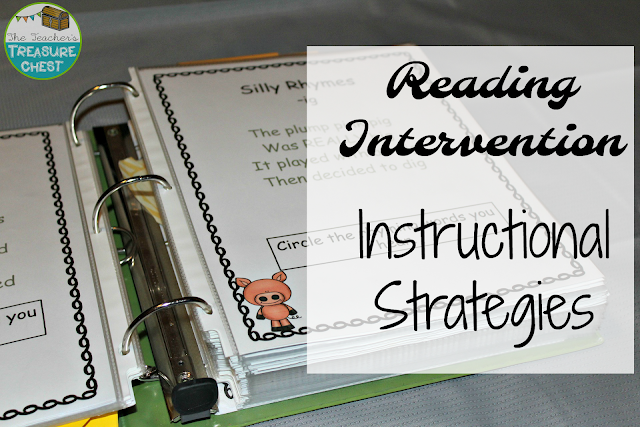Hey! I wanted to share with you some different strategies we used this past year for reading intervention. My
Reading Specialist and I worked together to create a series of
Reading Intervention Binders to help our teachers with reading intervention. There are SO many strategies and ways to do intervention, but it makes it so much easier having a program to follow. We use this binder during our intervention time and at the beginning of each guided reading lesson. We focus on word work, phonics, sight words and vocabulary first. Then, each binder moves into fluency and comprehension. They are designed so you can use them with a variety of reading levels. I am a firm believer in a separate intervention time every day. I usually do this during the last 15 minutes of every day. It's challenging, but it is so powerful to revisit those struggling readers outside of your normal reading block.
One thing we tried to do was provide a variety of ways to reach your students. Each
binder includes assessments so that you can see which part of the binder will most help your students. We use
Fountas and Pinnell Benchmark System in order to track our students progress. I give the benchmark once a grading period, but do informal running records in between.
Here's how often we are required to give informal running records:
Running records are a great way to determine a students weakness in a quick fashion. The most important component is analyzing the running record!
We use the following chart for our first grade students as they progress through their reading levels:
The
intervention binder is designed to start at the basic level for each
grade level.
All of the binders address the components of reading and the literacy continuum.
Word families are a great way to introduce students to decoding skills while teaching vocabulary at the same time! Our
Word Families Binder is designed for the Kindergarten- Second Grade classroom! Students who are struggling with decoding should start with word families because they are easier to decode. We begin with short vowels and then move into digraphs/blends.
Students have the opportunity to build vocabulary through learning synonyms and antonyms.
Decoding is an important skill that can hinder a students reading ability. These pages were designed to help students segment and blend words together.
We've got all components covered! Fluency passages are also included.


The
first grade binder includes preprimer, primer and first grade sight word activities. My students love using these pages. They are designed to be no prep but still effective. I often use these as morning work or as a warm up to our intervention lesson. I've also used them in our writing groups. Students have to create sentences based on these words. Students need repetitive practice with familiar words. A few weeks after I've assessed my students, I'll give them these words again and have them practice them in different ways. That way, students show a higher level of mastery. Sometimes students seem like they know the words because we've "skilled and drilled them". That's why I like to revisit previously taught words or skills about a month later, so I can be sure they've developed a deeper understanding. We often think of spiral review so much in math and sometimes forget that reading requires spiral review as well!

For this activity, we use it in several different ways. One way to is have the students place a marble or counter in the box next to the sentence you say. The other is to have one reader read a sentence out loud and have the other students move their counter to the correct sentence. To do this, I simply print two sets of the same page and spread them out. It should work out to where the student next to them has a different page.
Sight word three in a row is a favorite! After I use these pages in small group instruction, I place them in a student binder at a reading station. The students know exactly how to play the game since we've practiced it in small groups. The other great thing about this is that words change and increase in difficulty so the students aren't just using the same two game boards over and over again. All of the binders have these activities, the words are just more difficult.
I prefer to do my reading intervention time separate from my reading block. I like to do this because I want my students to practice reading all day long. We should consider ourselves reading teachers all day long. When we have a large amount of students below grade level, I always try to take a mental inventory of how much print they are exposed to. We cannot change what happens when they leave our rooms each day, however, we can expose them to as much print as possible when they are under our care :)
As with any intervention system, assessment drives instruction. Use your benchmark or diagnostic data to determine where your students need the most help! I LOVE chatting about data, so feel free to e-mail me or message me on Facebook about your specific needs!
Here are the binders in pictures:

Word Families
Third Grade
Click
here to download the reading development chart and running record forms.















































